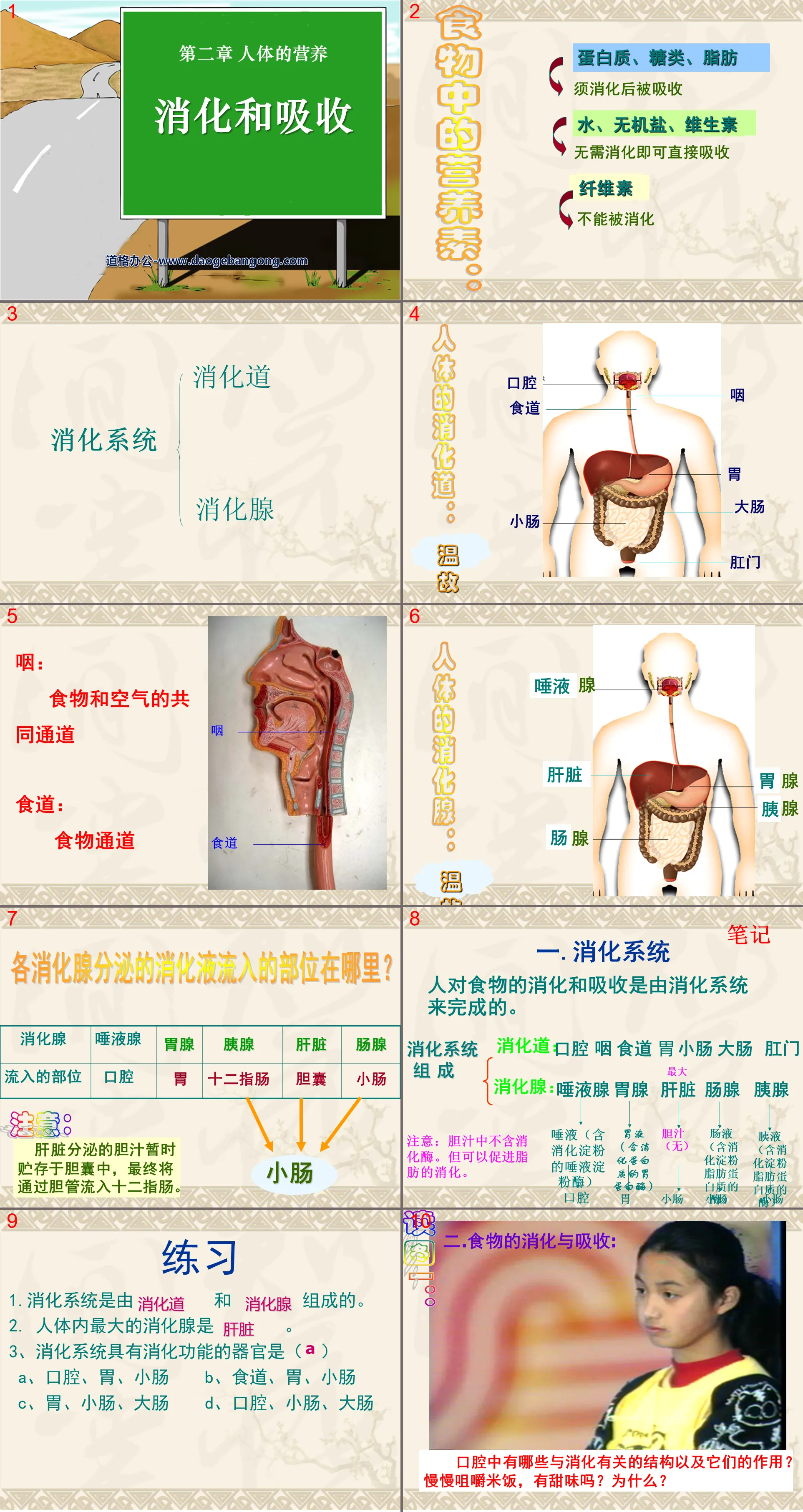People's Education Edition Biology for Grade 8, Volume 1
People's Education Edition seventh grade biology volume 1
People's Education Edition Biology for Grade 8, Volume 2
People's Education Press High School Biology Compulsory Course 2
Beijing Normal University Edition Seventh Grade Biology Volume 2
People's Education Press seventh grade biology book volume 2
Beijing Normal University Edition Eighth Grade Biology Volume 2
Beijing Normal University Edition Seventh Grade Biology Volume 1
Beijing Normal University Edition Eighth Grade Biology Volume 1
High School Biology Compulsory Course 1, published by People's Education Press
Jiangsu Education Edition Seventh Grade Biology Volume 1
Jiangsu Education Edition 8th Grade Biology Volume 1
Jiangsu Education Edition Seventh Grade Biology Volume 2
Jiangsu Education Edition 8th Grade Biology Volume 2

| Category | Format | Size |
|---|---|---|
| People's Education Press seventh grade biology book volume 2 | pptx | 6 MB |
Description
"Digestion and Absorption" Human Nutrition PPT Courseware 6
1. Digestive system
The digestion and absorption of food by humans is completed by the digestive system.
digestive system components
Digestive tract: oral cavity, pharynx, esophagus, stomach, small intestine, large intestine, anus
Digestive glands: salivary glands, gastric glands, liver, intestinal glands, pancreas
NOTE: Bile does not contain digestive enzymes. But it can promote the digestion of fat.
practise
1. The digestive system is composed of the digestive tract and digestive glands.
2. The largest digestive gland in the human body is the liver.
3. The organ with digestive function in the digestive system is ( )
A. Oral cavity, stomach, small intestine B. Esophagus, stomach, small intestine
C. Stomach, small intestine, large intestine D. Oral cavity, small intestine, large intestine
2. Digestion and absorption of food:
What structures are there in the mouth related to digestion and what are their functions? Chew the rice slowly. Is it sweet? Why?
Changes of steamed buns in the oral cavity
hint:
1. Design a set of experiments, some only explore the chewing of teeth and stirring of tongue, some only explore the role of saliva, some explore both chewing of teeth and stirring of tongue, and some explore the role of saliva.
2. Pay attention to the method of collecting saliva.
3. The oral temperature is about 37℃.
4. Starch has no sweetness, but the maltose formed after starch is decomposed has sweetness.
5. Starch turns blue when exposed to iodine, but maltose does not turn blue when exposed to iodine.
think:
1. Why do you need to put the test tube into a beaker filled with 37°C warm water?
37 degrees Celsius is close to the human oral temperature and is the optimal temperature required for enzyme catalysis.
2. What are the changes in color of the solutions in test tube A and test tube B? What does it mean?
The color of the solution in test tube A did not turn blue, indicating that the starch in the test tube was decomposed
B.C The color of the test tube turns blue, indicating that the starch in the test tube has not been decomposed
3. What is the purpose of setting up B.C test tube?
Conclusions of this experiment:
1. Digestion methods: physical digestion and chemical digestion
2. The oral cavity only has the ability to initially digest starch. (small portion)
3. Determining factor: Salivary amylase in saliva
4. The benefits of chewing slowly: food and saliva are fully mixed, which helps physical digestion in the mouth and reduces the burden on the gastrointestinal tract.
What structural characteristics does the small intestinal wall have that are compatible with its digestive and absorptive functions?
(1) The small intestine has many folds and villi (expanding the internal surface area of the small intestine)
(2) Rich capillaries have only a thin layer of epithelial cells
(good for absorbing nutrients)
(3) The small intestine is long and contains a variety of digestive juices (food stays for a long time, which is conducive to digesting nutrients)
The inner wall of the small intestine has countless tiny finger-like protrusions called small intestinal villi, which can greatly increase the absorption area of the small intestine.
practice
1. The initial digestion site of starch is __________.
2. Do all sugars taste sweet?
3. The initial site of protein digestion is ________.
4. The main place for absorbing nutrients is ________.
5. Which of the following structures has nothing to do with the absorptive function of the small intestine ( )
A. Folds and villi on the inner wall of the small intestine
B. The intestinal glands in the small intestine can secrete a variety of digestive juices
C. There are a large number of small intestinal villi and the wall is thin
D. There are abundant capillaries in the villi of the small intestine
6. The organ that starts digestion of sugars, proteins, and fats is ( )
A. Stomach, small intestine, large intestine B. Oral cavity, stomach, small intestine
C. Oral cavity, stomach, liver D. Oral cavity, small intestine, large intestine
7. Which of the following digestive juices causes physical changes in digesting food ( )
A. Pancreatic juice B. Gastric juice C. Bile D. Intestinal juice
Practical inquiry questions:
How do humans digest a pork burger with vegetables?
A. When you see the delicious hamburger, you start to secrete saliva and a small amount of gastric juice and gastric acid through visual and olfactory reflexes.
B. When the burger is eaten in the mouth, saliva separates a large amount of liquid and begins to digest starch into sugar (so when eating white rice or white toast, there will be a sweet taste), which is ground by the teeth and stirred by the tongue to form a food bolus. , and swallowed into the esophagus.
C. The esophagus cannot digest food, but it can secrete mucus and peristalsis to deliver the food bolus into the stomach.
D. The stomach can secrete gastric juice and gastric acid.
1. Stomach acid can sterilize bacteria and aid digestion
2. Gastric juice contains:
a. Mucus: protects the stomach wall
b. Digestive enzymes: can digest pork (protein) under acidic conditions to form chyme
c. The stomach can only absorb alcohol, drugs, caffeine, etc., but not digested burgers
E. After the chyme from the stomach enters the duodenum, the bile and alkaline pancreatic juice mix with the acidic chyme and become alkaline, which further digests protein, fat, vegetables, and sugar, and begins to absorb nutrients.
Keywords: human body nutrition teaching courseware, digestion and absorption teaching courseware, New People's Education Edition seventh grade biology PPT courseware volume 2, seventh grade biology slide courseware download, human body nutrition PPT courseware download, digestion and absorption PPT courseware download,. ppt format
For more information about the "Human Body's Nutrient Digestion and Absorption" PPT courseware, please click the Human Body's Nutrient Digestion and Absorption ppt tab.
"Digestion and Absorption" Human Nutrition PPT Courseware 5:
"Digestion and Absorption" Human Nutrition PPT Courseware 5 Every day we eat a variety of foods to ensure that we obtain adequate nutrition. The types of food vary: rice, steamed buns, various vegetables, fruits, meat, eggs, milk, etc. Some people eat a lot but don't get fat, but...
"Digestion and Absorption" Human Nutrition PPT Courseware 4:
"Digestion and Absorption" Human Nutrition PPT Courseware 4 Digestion: Organic substances with large molecules and complex structures such as starch, fat and protein, after entering the digestive system, are gradually decomposed into simple substances before they can be absorbed by the human body. This process is called digestion. (Textbook page 26) Food...
"Digestion and Absorption" Human Nutrition PPT Courseware 3:
"Digestion and Absorption" Human Nutrition PPT Courseware 3 Learning Objectives 1. Describe the composition of the human digestive system. 2. Based on the digestive system diagram, outline the process of food digestion. 3. Through the experiment of exploring the changes of steamed buns in the mouth, it is concluded that the initial changes of food in the digestive system...
File Info
Update Time: 2024-11-24
This template belongs to biology courseware People's Education Press seventh grade biology book volume 2 industry PPT template
"Digestion and Absorption" Human Nutrition PPT Courseware 6 Simple campus recruitment activity planning plan summary enterprise and institution recruitment publicity lecture PPT template is a general PPT template for business post competition provided by the manuscript PPT, simple campus recruitment activity planning plan summary enterprise and institution recruitment promotion Lecture PPT template, you can edit and modify the text and pictures in the source file by downloading the source file. If you want more exquisite business PPT templates, you can come to grid resource. Doug resource PPT, massive PPT template slide material download, we only make high-quality PPT templates!
Tips: If you open the template and feel that it is not suitable for all your needs, you can search for related content "Digestion and Absorption" Human Nutrition PPT Courseware 6 is enough.
How to use the Windows system template
Directly decompress the file and use it with office or wps
How to use the Mac system template
Directly decompress the file and use it Office or wps can be used
Related reading
For more detailed PPT-related tutorials and font tutorials, you can view: Click to see
How to create a high-quality technological sense PPT? 4 ways to share the bottom of the box
Notice
Do not download in WeChat, Zhihu, QQ, built-in browsers, please use mobile browsers to download! If you are a mobile phone user, please download it on your computer!
1. The manuscript PPT is only for study and reference, please delete it 24 hours after downloading.
2. If the resource involves your legitimate rights and interests, delete it immediately.
3. Contact information: service@daogebangong.com
"Digestion and Absorption" Human Nutrition PPT Courseware 6, due to usage restrictions, it is only for personal study and reference use. For commercial use, please go to the relevant official website for authorization.
(Personal non-commercial use refers to the use of this font to complete the display of personal works, including but not limited to the design of personal papers, resumes, etc.)
Preview










